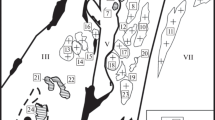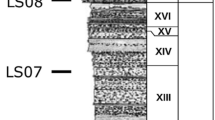Abstract
Back in the late 18th century, J.-B. Lamarck, a famous French representative of Neptunism, believed that granites were of aqueous origin, but at that time he could not provide compelling data to substantiate his point of view, and the opinion of Plutonists, who held that granites had a magmatic genesis, won. The latter approach was challenged by V.I. Vernadsky, who considered granites as “traces of bygone biospheres.” However, even today geological science follows the views of Plutonists despite insuperable barriers on this way. The author of this article substantiates a fundamentally new and previously unknown mechanism of granite formation through the transformation of basalts by water. He shows that the water–basalt system always contains a nonequilibrium state that ensures the continuous dissolution of the latter and the formation of new minerals and entire rock massifs, the composition of which depends on the time of evolution of the water–rock system. The granitization of basalts is the final stage of evolution in nonliving matter.
Similar content being viewed by others
References
V. V. Adushkin and A. V. Vityazev, “The origin and evolution of the Earth: A contemporary view,” Herald Russ. Acad. Sci. 77 (3), 232–238 (2007).
V. L. Khomichev, “Plutons–dikes–mineralizations,” Otechestvennaya Geol., No. 2, 90–96 (2012).
S. L. Shvartsev, “Why is there no granite layer in the oceanic crust?,” in Geological Evolution of Interaction between Water and Rocks: Proceedings of the All-Russia Conference with the Participation of Foreign Scientists (Izd. NTL, Tomsk, 2012), pp. 49–55 [in Russian].
S. L. Shvartsev, “The basic contradiction that predetermined the mechanisms and vector of global evolution,” Herald Russ. Acad. Sci. 85 (4), 342–351 (2015).
Yu. P. Rassadkin, Water Usual and Unusual (Galereya STO, Moscow, 2008) [in Russian].
S. L. Shvartsev, “Fundamental mechanisms of interaction in the water–rick system and its internal geological evolution,” Litosfera, No. 6, 3–24 (2008).
S. L. Shvartsev, B. N. Ryzhenko, V. A. Alekseev, et al., Geological Evolution and Self-Organization of the Water–Rock System, Vol. 2: Water–Rock System in the Conditions of the Hypergenesis Zone, Ed. by B. N. Ryzhenko (Izd. SO RAN, Novosibirsk, 2007) [in Russian].
I. Prigogine and I. Stengers, Order out of Chaos. Man’s New Dialogue with Nature (Heinemann, London, 1984).
S. L. Shvartsev, “Self-organizing abiogenic dissipative structures in the geologic history of the Earth,” Earth Sci. Frontiers 16 (6), 257–275 (2009).
C. D. Ollier, Weathering (Elsevier, New York, 1969; Nedra, Moscow, 1987).
S. L. Shvartsev, Hydrogeochemistry of the Hypergenesis Zone, 2nd ed. (Nedra, Moscow, 1998) [in Russian].
S. L. Shvartsev, “Geochemistry of fresh groundwater in the main landscape zones of the Earth,” Geochem. Intern 46 (13), 1285–1398 (2008).
A. I. Perel’man, Geochemistry, 2nd ed. (Vysshaya Shkola, Moscow, 1989) [in Russian].
A. A. Makhnach, Catagenesis and Groundwater (Nauka i Tekhnika, Minsk, 1989) [in Russian].
V. N. Kholodov, Geochemistry of the Sedimentary Process (GEOS, Moscow, 2006) [in Russian].
Sedimentary Basins: Methodology for Study, Structure, and Evolution, Ed. by Yu. G. Leonov and Yu. A. Volozh (Nauchnyi Mir, Moscow, 2004) [in Russian].
S. L. Shvartsev, T. N. Silkina, E. A. Zhukovskaya, and V. V. Trushkin, “Underground waters of petroliferous deposits of the Nyurol’ka sedimentary basin (Tomsk region),” Russ. Geol. Geophys. 44 (5), 451–464 (2003).
A. M. Plyusnin, L. V. Zamana, S. L. Shvartsev, et al., “Hydrogeochemical peculiarities of the composition of nitric thermal waters in the Baikal Rift Zone,” Rus. Geol. and Geophys. No. 5, 495–508 (2013).
S. L. Shvartsev, L. V. Zamana, A. M. Plyusnin, and O. G. Tokarenko, “Equilibrium of nitrogen rich spring waters of the Baikal Rift Zone with host rock minerals as a basis for determining mechanisms of their formation,” Geochem. Intern. No. 8, 713–725 (2015).
E. A. Baskov and S. N. Surikov, The Earth’s Hydrothermal Springs (Nedra, Leningrad, 1989) [in Russian].
D. S. Korzhinskii, Theory of Metasomatic Zonality, 2nd ed. (Nauka, Moscow, 1982) [in Russian].
A. V. Kopeliovich, Epigenesis of Ancient Southwestern Strata of the Russian Platform (Nauka, Moscow, 1965) [in Russian].
J. R. Boles, “Active albitization of plagioclase, Gulf Coast Tertiary,” Amer. J. of Sci. 282, 165–180 (1982).
T. R. Walker, “Diagenetic albitization of potassium Feldspar in Arkosic Sandstones,” J. Sedim. Petrol., No. 1, 3–16 (1984).
M. Ben Baccar, B. Fritz, and B. Made, “Diagenetic albitization of K-feldspar and plagioclase in sandstone reservoirs: Thermodynamic and kinetic modeling,” J. of Sedim. Petrol., No. 6, 1100–1109 (1993).
A. Putnis and H. Austrheim, “Fluid induced processes: Metasomatism and metamorphism,” Geofluids 10, 254–269 (2010).
D. E. Harlov, R. Wirth, and C. J. Hetherington, “Fluid-mediated partial alteration in monazite: The role of coupled dissolution—reprecipitation in element redistribution and mass transfer,” Contrib. to Mineral. and Petrol. 162, 329–348 (2011).
D. Upadhyay, “Alteration of plagioclase to nepheline in the Khariar alkaline complex, SE India: Constraints on metasomatic replacement reaction mechanisms,” Lithos 155, 19–29 (2012).
A. Minissale, G. Magro, F. Tassi, and C. Verrucchi, “Origin and circulation patterns of deep and shallow hydrothermal fluids in the Mt. Amiata geothermal region (central Italy),” in Proc. of the 8th Int. Symp. onWater–Rock Interaction, Ed. by Y. Kharak and O. V. Chudaev (Balkema, Rotterdam, 1995), pp. 523–528.
S. L. Shvartsev, “The internal evolution of the water–rock geological system,” Herald Russ. Acad. Sci. 82 (2), 134–142 (2012).
A. B. Ronov, Stratisphere, or the Earth’s Sedimentary Shell (A Quantitative Study) (Nauka, Moscow, 1993) [in Russian].
V. I. Vernadsky, Collected Works, Vol. 9: Chemical Structure of the Earth’s Biosphere and Its Environment. Biosphere and Noosphere (Nauka, Moscow, 2013) [in Russian].
Author information
Authors and Affiliations
Corresponding author
Additional information
Original Russian Text © S.L. Shvartsev, 2016, published in Vestnik Rossiiskoi Akademii Nauk, 2016, Vol. 86, No. 12, pp. 1106–1120.
Stepan L’vovich Shvartsev, Dr. Sci. (Geol.–Mineral.), is Chief Researcher at the Tomsk Branch of the Trofimuk Institute of Petroleum Geology and Geophysics (IPGG), RAS Siberian Branch, and a Professor at the National Research Tomsk Polytechnic University (TPU).
Rights and permissions
About this article
Cite this article
Shvartsev, S.L. Unknown mechanisms of granitization of basalts. Her. Russ. Acad. Sci. 86, 513–526 (2016). https://doi.org/10.1134/S1019331616060149
Received:
Published:
Issue Date:
DOI: https://doi.org/10.1134/S1019331616060149




